The ASUS ZenBook 3 Review: A Convincing Case for Quad Core Thin & Light Laptops
by Brett Howse on November 22, 2017 8:00 AM EST- Posted in
- Laptops
- Asus
- Zenbook
- Core 8th Gen
- Kaby Lake Refresh
GPU Performance
Although the move to 8th Generation Core has brought a nice jump in CPU performance, the same can’t be said for the integrated GPU. Here Intel is using the UHD 620, which other than a minor clockspeed bump, is largely the same as the HD 620 iGPU found on Kaby Lake. At the moment, there are no Iris equipped GPUs either, although that’s not unusual, since they tend to get launched later on. It’ll be curious to see if Intel launches any Iris based Core i7 models based on Kaby Lake Refresh, since they’ve already used up extra die space for more CPU cores.
We’ve already seen Intel announce that they will be building CPUs with AMD's Radeon graphics, but those are going to be targeted at the H series chips, which are the 45-Watt lineup, so on the Ultrabook end of things, the HD 620 is all we’re going to get for now.
The integrated GPUs on Core products have always been a sore spot, since they can generally run desktop workloads just fine, but any additional workloads tend to make them really struggle. Only the lightest games are generally playable at low resolutions, and the only compute available is QuickSync.
Since this is an Ultrabook, we’ve not stressed it like a gaming system, but instead kept to a couple of synthetics, and then one game which can be playable on lower-end hardware.
3DMark

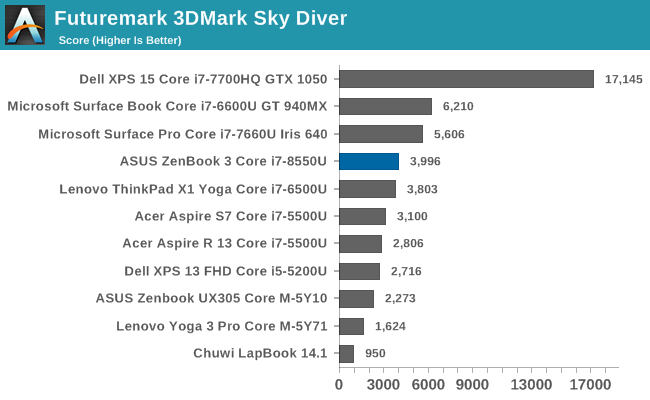
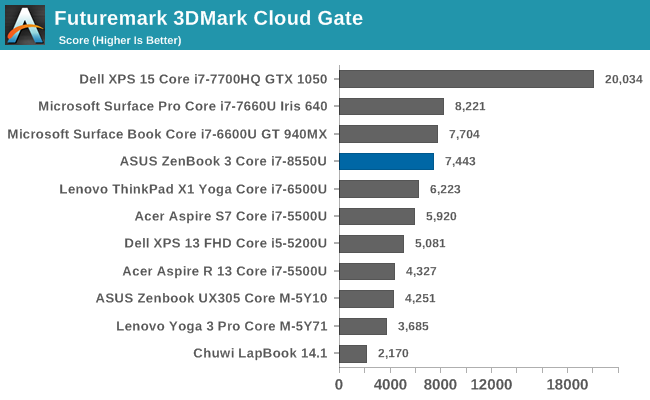
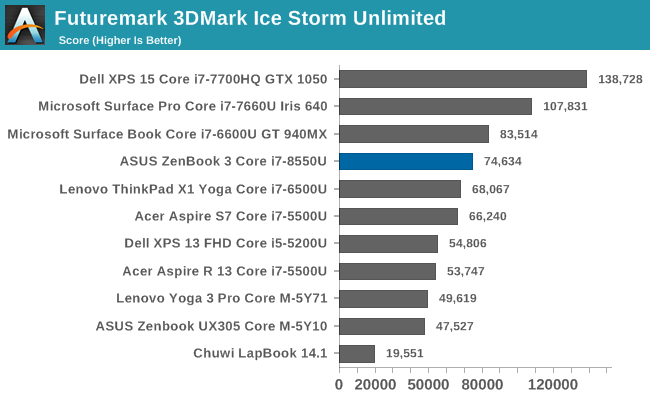
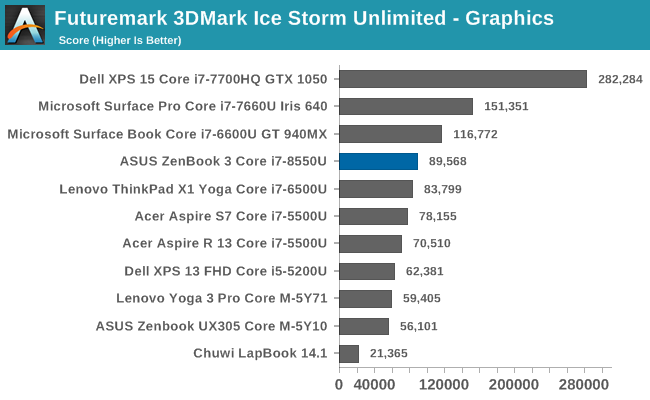

FutureMark has continuously updated it’s 3DMark suite, offering newer tests for even more powerful hardware, but there’s no need to worry about that with integrated graphics. The HD 620 of the ZenBook 3 slots in about where it’s expected, behind the Iris graphics in the Surface Pro, and below the discrete graphics in the Surface Book, which is the GT 940MX on the original, and well below the GTX 1050 on the Dell XPS 15.
GFXBench
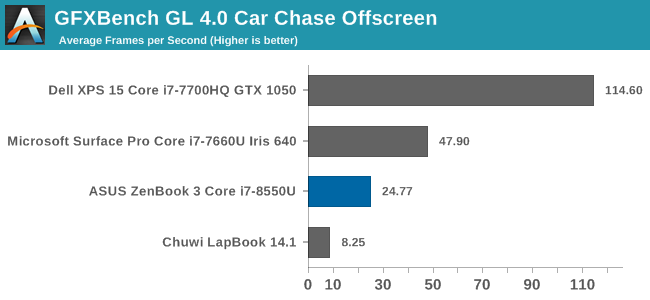
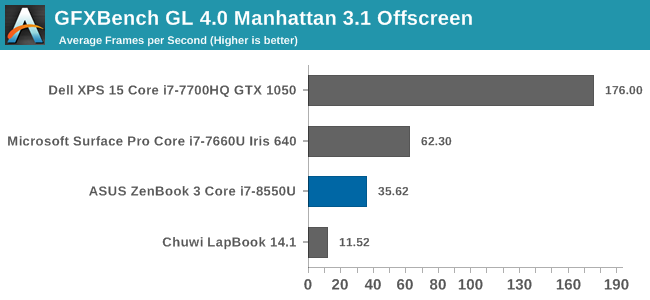
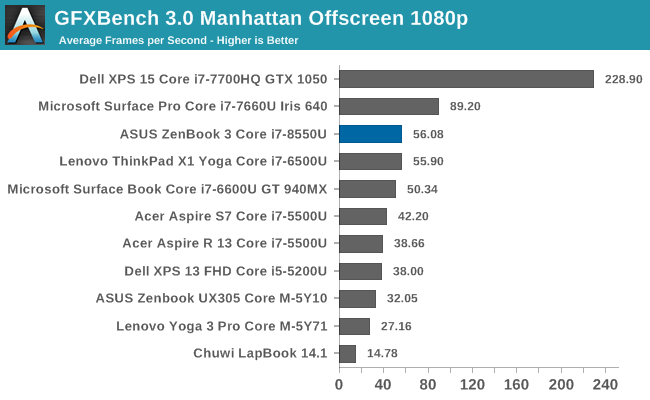
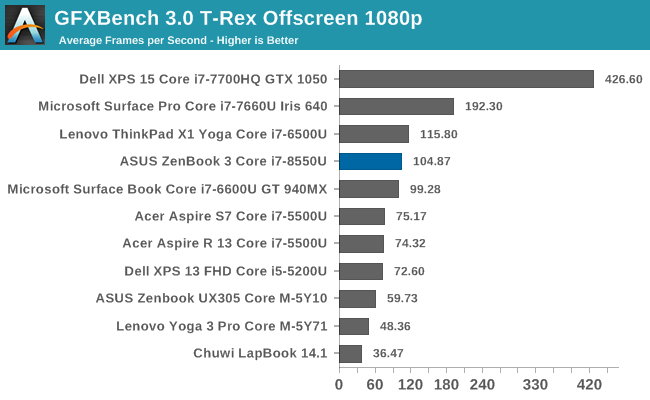
GFXBench is a set of tests that are cross-platform, although the desktop version is OpenGL based and runs at 32-bit precision, rather than the 16-bit precision of mobile devices. Once again, the HD 620 is not very fast, and sits well behind the Iris Plus Graphics 640 in the Surface Pro.
Dota 2 Reborn
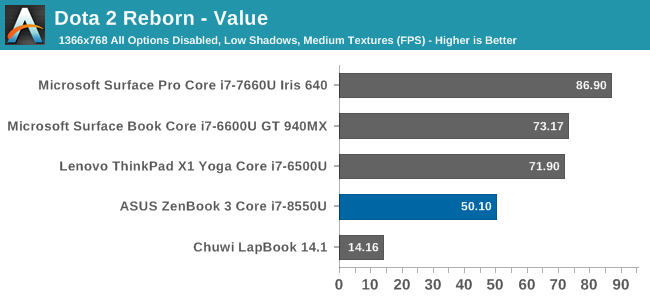
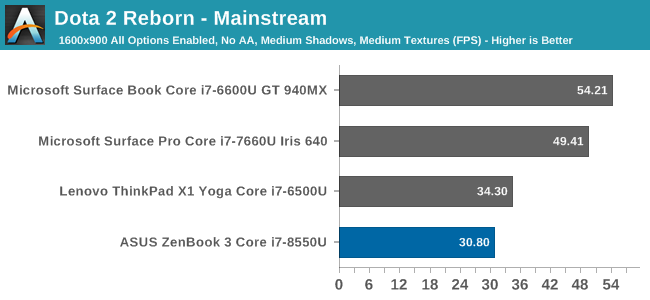
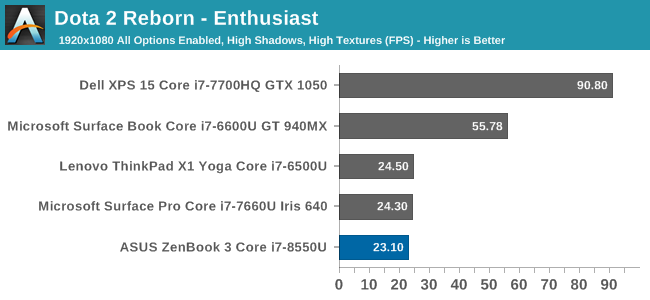
The one game tested is Vavle’s Dota 2, which can run fairly well even on low-end GPUs. The value settings, especially, offer reasonable performance from even integrated graphics. When playing a game, the performance of the ZenBook 3 falls even further behind. Even on the most basic settings, the game can’t quite hit 60 FPS, although all of the integrated GPU systems fall short at our Enthusiast settings.
Storage Performance
ASUS offers two SSD options in the ZenBook 3 UX490UA. The 256 GB is a SATA based SSD, but the larger 512 GB model is a NVMe PCIe 3.0 x4 model. In our review unit is the larger drive, which as it turns out is a Samsung PM961. This is a TLC drive, but thanks to the combination of Samsung’s Polaris controller and their 48-layer V-NAND, performance is very good.
The drive maxes out the PCIe link on reads, and still offers about 1.5 GB/s write speeds under sequential loads. The random read and write speeds are also very solid, assuming you stay in the SLC cache, which for most operations, that shouldn’t be a problem. The PM961 generally outperforms the SM951 MLC drive which was the top option not very long ago.


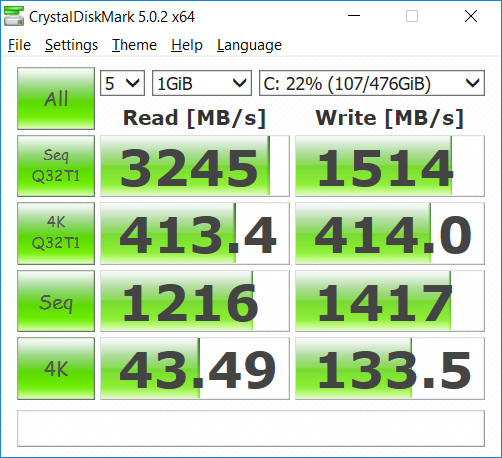








55 Comments
View All Comments
lefty2 - Wednesday, November 22, 2017 - link
The Cinebench multithread score look very weak. Only 497. The Ryzen 2700U scores 707Dr. Swag - Wednesday, November 22, 2017 - link
When it's allowed to turbo to the max, that is. If you put it in a laptop where you're more thermal and power constrained it's gonna give similar performance to this.If you look here it's only scoring 550 or so
https://images.anandtech.com/doci/11964/amd_ryzen_...
The 700 number was definitely with good cooling and maybe even the CPU set to the 25w mode. To achieve over 700 the CPU would need to be boosting to 3.3 ish ghz which is not reasonable to see in a laptop.
lefty2 - Wednesday, November 22, 2017 - link
(Sorry, posted this wrong)The 707 score is for a 15w laptop. Also, some redditors benchmarked the envy x360, which has a ryzen 5 2500u, that scored 577
neblogai - Wednesday, November 22, 2017 - link
Did Anandtech run Cinebench on Asus a single time, or in long loop? Did not see the answer when fast-reading the article. Ryzen Mobile in HP x360 with 2500U scored up to 614 for users in a single run, and AMD showed ~550 to be expected in continuous load at 25W. However- this Asus is a laptop weighing only half of what HP x360 weighs, thus lower cTDP/shorter boost time is reasonable.DanNeely - Wednesday, November 22, 2017 - link
Not sure, but in the power analysis section of the article it stated that after an initial burst the laptop dropped its CPU power down to 15W; so falling behind a 25W system is only to be expected. The graph in that section's bobbing up and down on temp/clock speed/etc suggests it was run long enough to reach steady state at least.lefty2 - Wednesday, November 22, 2017 - link
It's a pity no review site wants to buy a Envy x360 and benchmark it properly. We could lay this to rest thenRyan Smith - Wednesday, November 22, 2017 - link
Our Envy is on its way.=)lefty2 - Wednesday, November 22, 2017 - link
Excellent!jjj - Thursday, November 23, 2017 - link
Hope you guys spend a bit of extra time on power (for just the RR SoC), it's a possible weak point given how little such data AMD shared.Krysto - Wednesday, November 22, 2017 - link
And how do we know this isn't this laptop's "peak performance", too? Maybe Intel's chip actually drops down to a score of 300 after it throttles...